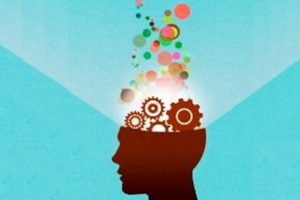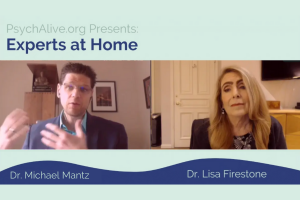Minding the Brain by Daniel Siegel, M.D.
An Excerpt from Dr. Daniel Siegel’s New Book Mindsight: The New Science of Personal Transformation.
If you put your thumb in the middle of your palm and then curl your fingers over the top, you’ll have a pretty handy model of the brain. (My kids can’t stand that pun, either.) The face of the person is in front of the knuckles, the back of the head toward the back of your hand. Your wrist represents the spinal cord, rising from your backbone, upon which the brain sits. If you lift up your fingers and raise your thumb, you’ll see the inner brainstem represented in your palm. Place your thumb back down and you’ll see the approximate location of the limbic area (ideally we’d have two thumbs, left and right, to make this a symmetric model). Now curl your fingers back over the top, and your cortex is in place.
These three regions—the brainstem, the limbic area, and the cortex— comprise what has been called the “triune” brain, which developed in layers over the course of evolution. At a very minimum, integrating the brain involves linking the activity of these three regions. Since they are distributed bottom to top— from the inward and lower brainstem region, to the limbic area, to the outer and higher cortex— we could call this “vertical integration.” The brain is also divided into two halves, left and right, so neural integration must also involve linking the functions of the two sides of the brain. This could be called “horizontal” or “bilateral integration.” (I’ll discuss bilaterality in chapter 6.) Knowing about the functions of the major regions of the brain can help you to focus your attention in ways that will create the desired linkage among them. So allow me to give you a brief overview of the layers of the triune brain.
THE BRAINSTEM
Hundreds of millions of years ago, the brainstem formed what some call the “reptilian brain.” The brainstem receives input from the body and sends input back down again to regulate basic processes such as the functioning of our heart and lungs. Beyond controlling the energy levels of the body through regulating heart rate and respiration, the brainstem also shapes the energy levels of the brain areas above it, the limbic and cortical regions. The brainstem directly controls our states of arousal, determining, for example, if we are hungry or satiated, driven by sexual desire or relaxed with sexual satisfaction, awake or asleep.
Clusters of neurons in the brainstem also come into play when certain conditions seem to require a rapid mobilization of energy distribution throughout the body and brain. This so- called fightflight-freeze array of responses is responsible for our survival at times of danger. Working in concert with the evaluative processes of both the limbic and the higher cortical regions, the brainstem is the arbiter of whether we respond to threats either by mobilizing our energy for combat or for flight, or by freezing in helplessness, collapsing in the face of an overwhelming situation. But whichever of these responses is chosen, when we are in survival mode our reactivity makes it quite challenging, if not outright impossible, to be open and receptive to others. So part of the process of developing mindsight involves reducing reactivity when it’s not actually necessary, as you will see later.
The brainstem is also a fundamental part of what are called “motivational
systems” that help us satisfy our basic needs for food,shelter, reproduction, and safety. When you feel a deep “drive” to behave in a certain way, chances are that your brainstem is working closely with the next- higher region, the limbic area, to push you to act.
THE LIMBIC REGIONS
The limbic area lies deep within the brain, approximately where your thumb is on the hand model. It evolved when small mammals first appeared around two hundred million years ago. This “old mammalian brain” works closely with the brainstem and the body proper to create not only our basic drives but also our emotions. These feeling states are filled with a sense of meaning because the limbic regions evaluate our current situation. “Is this good or is this bad?” is the most basic question the limbic area addresses. We move toward the good and withdraw from the bad. In this way the limbic regions help create the “e- motions” that “evoke motion,” that motivate us to act in response to the meaning we assign to whatever is happening to us in that moment.
The limbic area is also crucial for how we form relationships and become emotionally attached to one another. If you’ve ever raised fish, or frogs, or lizards, you know that these nonmammalian creatures lack attachment to you— and to one another. Rats, cats, and dogs, on the other hand, are equipped with a mammalian limbic region. Attachment is just what they— and we— do. We are hardwired to connect with one another thanks to our mammalian heritage.
The limbic area plays an important regulatory role through the hypothalamus, a master endocrine control center. Via the pituitary gland, the hypothalamus sends and receives hormones throughout the body— especially influencing our sexual organs and the thyroid and adrenal glands. For example, when we are stressed we secrete a hormone that stimulates the adrenals to release cortisol, which mobilizes energy by putting our entire metabolism on high alert to meet the challenge. This response is highly adaptive in the face of shortterm stress, but it can turn into a problem in the long term. If we face an overwhelming situation in which we cannot adequately cope, cortisol levels may become chronically elevated. Traumatic experiences, in particular, can sensitize limbic reactivity, so that even minor stresses can cause cortisol to spike, making daily life more challenging for the traumatized person. These high cortisol levels can also be toxic to the growing brain and interfere with proper growth and function of neural tissue. Finding a way to soothe excessively reactive limbic firing is crucial to rebalancing emotions and diminishing the harmful effects of chronic stress. As we’ll see, mindsight can help us recruit the higher areas of the brain to create a “cortical override” of these limbic reactivities.
The limbic area also helps us create several different forms of memory— of facts, of specific experiences, of the emotions that gave color and texture to those experiences. Located to either side of the central hypothalamus and pituitary, two specific clusters of neurons have been intensively studied in this regard: the amygdala and the hippocampus. The almond- shaped amygdala has been found to be especially important in the fear response. (Although some writers attribute all emotions to the amygdala, more recent research suggests that our general feelings actually originate from more broadly distributed areas of the limbic zone, the brainstem, and the body proper, and are woven into our cortical functioning as well.)
The amygdala can prompt an instantaneous survival response. Once, when my son and I were hiking in the High Sierra, a sudden jolt of fear brought me to a halt and I yelled out to him, “Stop!” Only after I yelled did I realize why— my constantly on- guard amygdala had seized upon a visual perception, beneath my conscious awareness, of a coiled object in our path. Luckily my son did stop (he wasn’t yet a resistant teenager) and was then able to step around the poised- for- action young rattlesnake who was sharing the trail with us. Here we see that emotional states can be created without consciousness, and we may act on them without awareness. This may save our lives— or it can cause us to do things we later regret deeply. In order for us to become aware of the feelings inside us— to consciously attend to and understand them— we need to link these subcortically created emotional states to our cortex.
Finally we come to the hippocampus, a sea horse– shaped cluster of neurons that functions as a master “puzzle- piece- assembler,” linking together widely separated areas of the brain— from our perceptual regions to our repository for facts to our language centers. This integration of neural firing patterns converts our moment- to-moment experiences into memories. I can relate the snake story to you because my hippocampus linked together the various aspects of that experience— sensations in my body, emotions, thoughts, facts, reflections— into a lived- in- time set of recollections.
The hippocampus develops gradually during our early years and continues to grow new connections and even new neurons throughout our lives. As we mature, the hippocampus weaves the basic forms of emotional and perceptual memory into factual and auto – biographical recollections, laying the foundation for my ability to tell you about that long- ago snake encounter in the Sierras. However, this uniquely human storytelling ability also depends upon the development of the highest part of the brain, the cortex.
THE CORTEX
The outer layer, or “bark,” of the brain is the cortex. It is sometimes called the “new mammalian” brain or neocortex because it expanded greatly with the appearance of primates— and most especially with the emergence of human beings. The cortex creates more intricate firing patterns that represent the three- dimensional world beyond the bodily functions and survival reactions mediated by the lower, subcortical regions. In humans, the more elaborate frontal portion of the cortex allows us to have ideas and concepts and to develop the mindsight maps that give us insight into the inner world. The frontal cortex actually makes neural firing patterns that represent its own representations. In other words, it allows us to think about thinking. The good news is that this gives us humans new capacities to think— to imagine, to recombine facts and experiences, to create. The burden is that at times these new capacities allow us to think too much. As far as we know, no other species represents its own neural representations— probably one reason why we sometimes call ourselves “neurotic.”
The cortex is folded into convoluted hills and valleys, which brain scientists have divided into regions they call lobes. On your hand model, the back or posterior cortex extends from your second knuckle (counting from the fingertips) to the back of your hand, and includes the occipital, parietal, and temporal lobes. The posterior cortex is the master mapmaker of our physical experience, generating our perceptions of the outer world— through the five senses— and also keeping track of the location and movement of our physical body through touch and motion perception. If you’ve learned to use a tool— whether it was a hammer, a baseball bat, or even a car— you may remember the magical moment when your initial awkwardness dropped away. The amazingly adaptive perceptual functions of the back of the cortex have embedded that object into your body- maps so that it is neurally experienced like an extension of your body. This is how we can drive rapidly on a freeway or park a car in a tight space, use a scalpel with precision, or attain a .300 batting average.
Looking again at your hand model, the front of the cortex, or frontal lobe, extends from your fingertips to the second knuckle.
This region evolved during our primate history and is most developed in our human species. As we move from the back toward the front, we first encounter a “motor strip” that controls our voluntary muscles. Distinct groups of neurons control our legs, arms, hands, fingers, and facial muscles. These neural groups extend to the spinal cord, where they cross over, so that we make our right- side muscles work by activating our left motor area. (The same crossover is true for our sense of touch, which is represented farther back in the brain, in a zone of the parietal lobe called the “somatosensory strip.”) Coming back to the frontal area and moving a bit more forward, we find a region called the “premotor” strip, which allows us to plan our motor actions. You can see that this part of the frontal lobe is still deeply connected to the physical world, enabling us to interact with our external environment.
THE PREFRONTAL CORTEX
As we move higher and more forward in the brain, we finally come to the area from your first knuckles to your fingertips on the hand model. Here, just behind the forehead, is the prefrontal cortex, which has evolved to this extent only in human beings.We have now moved beyond the neural concerns for the physical world and the movement of the body and into another realm of neurally constructed reality. Beyond the bodily and survival concerns of the brainstem, beyond the evaluative and emotional limbic functions, beyond even the perceptual processes of the posterior cortex and the motor functions of the posterior portion of the frontal lobe, we come upon the more abstract and symbolic forms of information flow that seem to set us apart as a species. In this prefrontal realm, we create representations of concepts such as time, a sense of self, and moral judgments. It is here also that we create our mindsight maps.
Look again at your hand model. The outer two fingertips represent the side prefrontal cortex, which participates in generating the conscious focus of attention. When you put something in the “front of your mind” you are linking activity in this region to activity from other areas of the brain, such as the ongoing visual perceptions from the occipital lobe. (Even when we generate an image from memory, we activate a similar portion of that occipital lobe.) When my amygdala perceived the rattlesnake without my conscious awareness, that perceptual “shortcut” likely took place without my side prefrontal involvement. Only later, after I’d yelled for my son to stop and felt my heart pounding, did my side prefrontal region get involved and permit me to figure out, consciously, that I’d been afraid of a snake.
Now focus on the middle two fingernail areas. We have arrived at the middle prefrontal area that was so severely damaged in Barbara’s accident. As I described earlier in this chapter, this area has important regulatory functions that range from shaping bodily processes—through overseeing brainstem activity— to enabling us to pause before we act, have insight and empathy, and enact moral judgments.
What makes this middle prefrontal region so crucial to carrying out these essential functions of a healthy life? If you lift your fingers up and put them back down, you’ll get a sense of the anatomical uniqueness of this region: It connects everything. Notice how your two middle fingertips rest on top of the limbic- thumb and touch the brainstem- palm, and are also linked directly to the cortex- fingers. So the middle prefrontal area is literally one synapse away from neurons in the cortex, the limbic area, and the brainstem. And, as I’ll discuss later, it even has functional pathways that connect us to the social world of other brains.
The middle prefrontal region creates links among the following widely separated and differentiated neural regions: the cortex, limbic areas, and brainstem within the skull, and the internally distributed nervous system of the body proper. It also links signals from all those areas to the signals we send and receive in our social world. As the prefrontal cortex helps coordinate and balance the firing patterns from these many regions, it is profoundly integrative. In the following chapter we’ll explore what happens when this integrative area goes off- line. Lift up your fingers and you’ll have an image of how we “flip our lids” and head down the “low road” in our interactions with others.
– Daniel J. Siegel, M.D. Mindsight: The New Science of Personal Transformation 2010, New York, NY: Bantam Books
Watch an exclusive PsychAlive video featuring Dr. Daniel Siegel discussing mindsight:
 See more videos from Dan Siegel at PsychAlive’s Video Center
See more videos from Dan Siegel at PsychAlive’s Video Center








great work on this article!!
Dr Eugene van Niekerk April 15, 2016 at 5:20 pm
nothing less than a masterpiece!
I have used the hand model with preschool age students and they love it – they can relate to the image when those big emotions come.